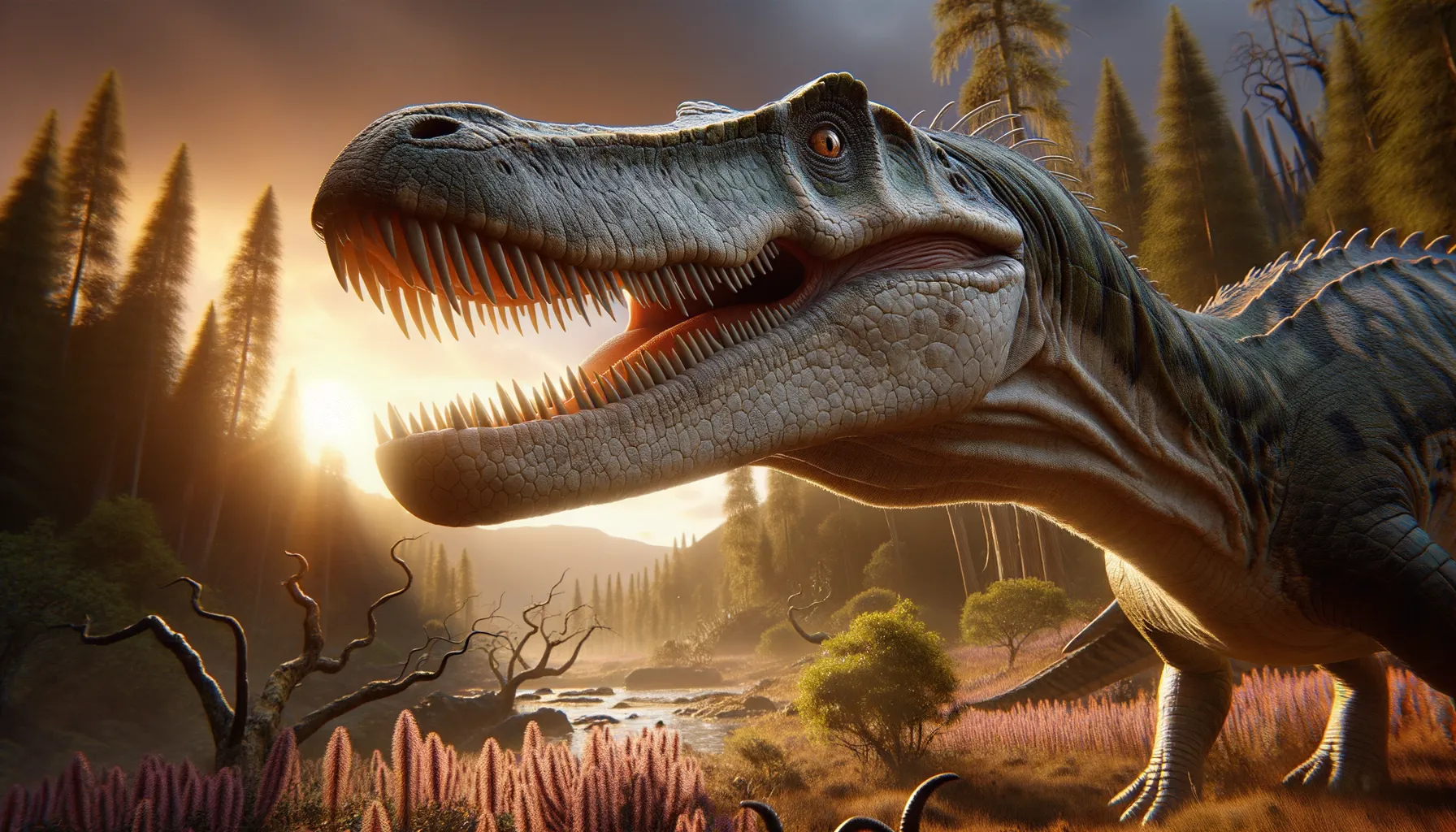
Oxalaia
Mighty predator of ancient Brazilian waters.
Period
Cretaceous
Length
Roughly 12 to 14 meters long.
Height
About 4 meters tall at the hip.
Weight
Approximately 5 to 7 tonnes.
Oxalaia was a large theropod dinosaur known for its crocodile-like appearance, living during the Cretaceous period in what is now Brazil. It is closely related to the Spinosaurus and is part of the Spinosauridae family. Its fossils indicate that it had a long, narrow snout filled with sharp teeth adapted for gripping slippery prey like fish. This dinosaur's remains were primarily found in Brazil, offering insight into the diverse prehistoric ecosystems of South America.
Diet
Oxalaia primarily fed on fish, using its long snout and sharp teeth to catch slippery prey. Its diet would have been supplemented by small terrestrial animals when possible.
Hunting
As a piscivore, Oxalaia likely hunted by wading in shallow waters or near riverbanks, waiting to snap up unsuspecting fish. Its jaw structure suggests a quick and effective grasp on prey, reducing the chance of escape.
Environmental challenges
Oxalaia faced the challenge of sourcing sufficient food in a competitive environment where large predators competed for similar prey. Seasonal changes in water levels could have impacted prey availability, requiring adaptability in hunting strategies. Additionally, maintaining its large body size would require a consistent food supply, presenting further survival challenges. Extreme weather conditions would also occasionally force this dinosaur to seek shelter or migrate in search of stable habitats.
Speed
Likely slow-moving due to its size.
Lifespan
Estimated around 50 years.
First discovery
Discovered in Brazil in 1999.
Fun Facts
- Oxalaia was a giant carnivorous dinosaur that lived in what is now Brazil during the Cretaceous period.
- It is related to the famous Spinosaurus and shared many similarities, such as the possibility of being semi-aquatic.
- Oxalaia is known from very limited fossil evidence, primarily consisting of two skull fragments, making it a bit of a mystery.
- This dinosaur is estimated to have been around 12 to 14 meters long, making it one of the largest theropods from South America.
- Oxalaia's name comes from an African deity, a nod to its shared ancestry with dinosaurs found in Africa.
- Researchers believe Oxalaia may have had a long, crocodile-like snout suited for catching fish.
- Since its first discovery in 1999, Oxalaia continues to intrigue paleontologists due to its elusive nature.
Growth and Development
Like many large theropods, Oxalaia would grow rapidly during its early years, reaching near-adult sizes within a decade. Juveniles would rely heavily on the protection of dense vegetation and water sources to avoid becoming prey themselves. As it matured, changes in tooth structure and jaw strength would signify readiness to tackle larger prey. Social interactions, possibly including parental guidance, would play a role in its development and learning of survival skills.
Habitat
Oxalaia inhabited regions with abundant water sources like rivers and coastal areas, supporting its fish-based diet. Seasonal flooding and drying of river systems would dictate its movement patterns. Dense vegetation along riverbanks offered both hiding spots for ambushes and safety from other large predators. Its environment was rich in biodiversity, providing numerous opportunities for interaction with other species.
Interaction with other species
Oxalaia likely competed with other large predators for food resources, sometimes leading to territorial disputes. It may have scavenged or monopolized carcasses left by other species when opportunity allowed. It coexisted with various herbivorous dinosaurs, often ignoring them unless in competition for water or space. Its size and predatory nature would ensure a dominant position in most ecological exchanges.
Natural lifespan
Oxalaia's natural lifespan is estimated to be around 50 years.
Reproduction
Reproductive strategies likely involved laying eggs in nests constructed along riverbanks or in soft sediment. The nesting sites would be chosen for safety and proximity to food sources, ensuring hatchlings' early survival chances. Parental care would possibly extend to basic protection and guidance for the first few months. Clutch sizes were varied, depending on environmental conditions and individual health.
Social behaviour
Oxalaia's social behavior might have involved loose associations with others, primarily during mating seasons. Solitary tendencies would dominate its lifestyle, but occasional cooperation for hunting or protection wasn't out of the question. Communication would involve vocalizations and physical displays, particularly in asserting dominance or during conflicts.
Fossil locations
Oxalaia fossils have been predominantly found in Brazil, specifically in the Alcântara Formation. The fossil sites are limited, making each discovery significant in understanding its ecology and biogeography. These locations highlight a once rich and diverse ecosystem teeming with aquatic and terrestrial life forms. Ongoing research in these areas may yield more information on this mysterious predator.
